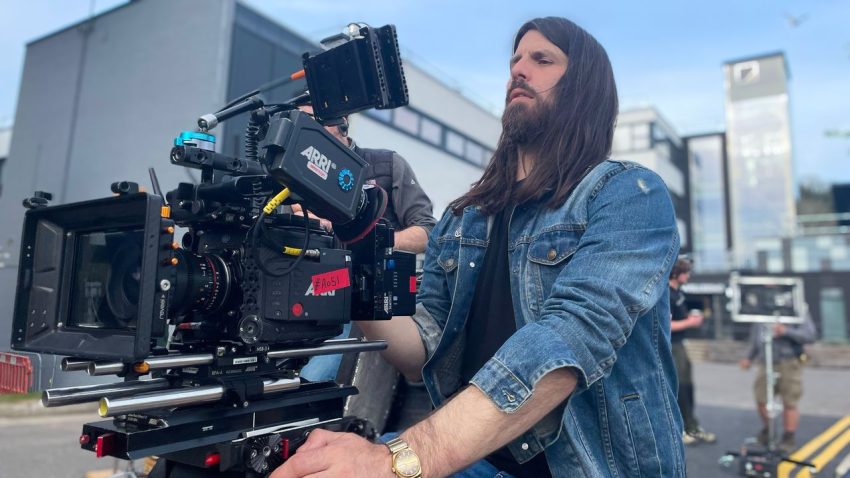Exploring the Art of Cinematography in “Sessions”
Cinematographer Andrew Rodger has been making waves in the film industry with his unique approach to visual storytelling. From his work on the cult movie No Way Up to his latest project, Sessions, he continues to push the boundaries of what is possible with both vintage and modern equipment. His recent collaboration on Sessions showcases a blend of retro aesthetics and cutting-edge technology that creates a distinct visual identity for the film.
Understanding the Story Behind Sessions
Sessions is a psychological thriller that follows the journey of a man who has lived a life steeped in the drinking and drug culture typical of many young English men. The narrative takes a dramatic turn as he is forced to re-evaluate his life, take responsibility, and become a grown-up. Central to the story is his friendship with a close companion, adding emotional depth to the film’s dark themes.
The film’s tone is intentionally bleak, both visually and thematically, but its writing and performances are praised for their beauty and authenticity. As the director of photography (DOP), Andrew plays a crucial role in translating the script’s mood into a visual language that resonates with the audience.
The Role of the Director of Photography
As the DOP, Andrew is responsible for camera and lighting placement, ensuring that the visual elements align with the director’s vision. He works closely with director Giles Alderson to capture the essence of the story through the lens. His team includes experienced professionals such as grip Frank Corr and gaffer Andy Rain, who have collaborated with him on previous projects like No Way Up and Three Day Millionaire.
Vintage Lenses and Their Impact on the Film’s Look
One of the most striking aspects of Sessions is its retro aesthetic, achieved through the use of vintage Takumar lenses. These Japanese lenses, produced from the 1950s to the 1970s, are known for their high-quality construction and unique softness. When paired with a modern camera like the Arri Alexa LF, they create a balance between the warmth of old lenses and the precision of new technology.
The Arri Alexa LF, a full-frame camera, allows for greater depth of field and resolution when using these lenses. This combination results in a more natural and cinematic look, with softer skin tones and a more organic feel to the lighting.
The Unique Quality of Vintage Lenses
Andrew emphasizes that the quality of vintage lenses cannot be easily replicated. The way light travels through the glass and the physical characteristics of the lenses contribute to a one-of-a-kind visual effect. These lenses often produce unexpected flares and artifacts, which can add an artistic dimension to the film. Instead of trying to eliminate these effects, Andrew embraces them, believing that they enhance the storytelling.
Adapting Vintage Lenses for Modern Use
To use the Takumar lenses on a modern camera, Andrew employs an EF to M42 adapter. This allows the vintage lenses to function with the Canon EF mount used by the Arri Alexa LF. While some modifications may be necessary, such as gearing the lenses for remote focusing, the process is manageable and cost-effective.
Sourcing and Cost of Vintage Lenses
Building a collection of Takumar lenses has been a five-year endeavor for Andrew. While some lenses are rare and expensive, others are relatively affordable, ranging from £30 to over £500. This affordability makes them an attractive option for smaller budget productions, allowing filmmakers to achieve a distinctive look without breaking the bank.
Color Theory and Visual Aesthetics
A notable feature of Sessions is its teal and orange color palette, which enhances the visual depth of the scenes. This color contrast creates a 3D effect, drawing attention to warmer tones in the foreground while pushing cooler backgrounds into the distance. It also makes the images more visually engaging and less fatiguing to the eye.
Specialized Lenses for Unique Shots
Andrew also utilized specialized macro lenses, such as a 20mm Vivitar, to capture close-up shots that add intimacy and intensity to the film. These lenses allowed for extreme close-ups, such as a shot of a cocaine rail, which required precise focus pulling to transition from a macro view to a wider shot.
Custom LUTs for a Retro Filmic Look
To further enhance the retro aesthetic, Andrew developed a custom LUT called Errorchrome. This look-up table emulates early 1980s and 1990s film stocks, providing a film-like contrast and exposure that complements the vintage lenses. The LUT helps guide the lighting and color grading process, ensuring consistency across the production.
Conclusion
Through his innovative use of vintage lenses, custom LUTs, and creative lighting techniques, Andrew Rodger has crafted a visually compelling film that bridges the gap between past and present. Sessions stands as a testament to the power of thoughtful cinematography and the enduring appeal of retro aesthetics in modern filmmaking.
